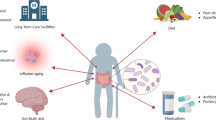Abstract
Pellagra is a vitamin disorder caused by deficiency in vitamin B3, also called niacin. It is a multi-systemic disorder that most commonly involves skin, nervous system, and gastrointestinal tract. Indeed, pellagra is often said to consist of “the four Ds”: dementia, diarrhea, dermatitis, and death. Nowadays it is not a very common disease in developed countries, and its lesions and presentations often resemble other diseases, so it is difficult to identify. For this reason, there are few epidemiological data available in literature. In the twenty-first century, pellagra has been largely eradicated by niacin fortification of food and diet diversification. Despite this, sporadic cases continue to occur.

Similar content being viewed by others
Availability of Data and Material
All data generated or analyzed during this study are included in this published article (and its supplementary information files).
Code Availability
Not applicable
References
Oldham MA, Ivkovic A. Pellagrous encephalopathy presenting as alcohol withdrawal delirium: a case series and literature review. Addict Sci Clin Pract. 2012;7(1):12. https://doi.org/10.1186/1940-0640-7-12.
Wan P, Moat S, Anstey A. Pellagra: a review with emphasis on photosensitivity. Br J Dermatol. 2011;164(6):1188–200. https://doi.org/10.1111/j.1365-2133.2010.10163.x.
World Health Organization. Pellagra and its prevention and control in major emergencies. WHO/NHD. 2000;00:10.
Li R, Yu K, Wang Q, Wang L, Mao J, Qian J. Pellagra secondary to medication and alcoholism: a case report and review of the literature. Nutr Clin Pract. 2016;31(6):785–9. https://doi.org/10.1177/0884533616660991.
Hui S, Heng L, Shaodong W, Fangyu W, Zhenkai W. Pellagra affecting a patient with crohn’s disease. An Bras Dermatol. 2017;92(6):879–81. https://doi.org/10.1590/abd1806-4841.20174461.
Author information
Authors and Affiliations
Contributions
Susi Girotti, Giuseppina Bitti, Alessandro Ciarrocchi, and Stefano Angelici analyzed and interpreted the patient data. Adele Agostini was a major contributor in writing the manuscript. All authors read and approved the final manuscript.
Corresponding author
Ethics declarations
Ethics Approval
The patient gave consent to the publication of the image. Patient cannot be identified.
Consent to Participate
The patient gave consent to the publication of the manuscript.
Consent for Publication
The patient gave consent to the publication of the image.
Conflict of Interest
The authors declare no competing interests.
Additional information
Publisher’s Note
Springer Nature remains neutral with regard to jurisdictional claims in published maps and institutional affiliations.
This article is part of the Topical Collection on Topical Collection on Medicine
Rights and permissions
About this article
Cite this article
Martino, G.P., Agostini, A., Girotti, S. et al. Pellagra: a Still Present Disease. SN Compr. Clin. Med. 3, 1801–1803 (2021). https://doi.org/10.1007/s42399-021-00949-6
Accepted:
Published:
Issue Date:
DOI: https://doi.org/10.1007/s42399-021-00949-6



